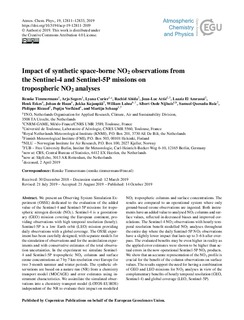| dc.contributor.author | Timmermans, Renske | |
| dc.contributor.author | Segers, Arjo | |
| dc.contributor.author | Curier, Lyana | |
| dc.contributor.author | Abida, Rachid | |
| dc.contributor.author | Attié, Jean-Luc | |
| dc.contributor.author | Lahoz, William A. | |
| dc.date.accessioned | 2019-11-19T15:34:07Z | |
| dc.date.available | 2019-11-19T15:34:07Z | |
| dc.date.created | 2019-11-08T12:04:05Z | |
| dc.date.issued | 2019 | |
| dc.identifier.citation | Atmospheric Chemistry and Physics. 2019, 19 12811-12833. | nb_NO |
| dc.identifier.issn | 1680-7316 | |
| dc.identifier.uri | http://hdl.handle.net/11250/2629351 | |
| dc.description.abstract | We present an Observing System Simulation Experiment (OSSE) dedicated to the evaluation of the added value of the Sentinel-4 and Sentinel-5P missions for tropospheric nitrogen dioxide (NO2). Sentinel-4 is a geostationary (GEO) mission covering the European continent, providing observations with high temporal resolution (hourly). Sentinel-5P is a low Earth orbit (LEO) mission providing daily observations with a global coverage. The OSSE experiment has been carefully designed, with separate models for the simulation of observations and for the assimilation experiments and with conservative estimates of the total observation uncertainties. In the experiment we simulate Sentinel-4 and Sentinel-5P tropospheric NO2 columns and surface ozone concentrations at 7 by 7 km resolution over Europe for two 3-month summer and winter periods. The synthetic observations are based on a nature run (NR) from a chemistry transport model (MOCAGE) and error estimates using instrument characteristics. We assimilate the simulated observations into a chemistry transport model (LOTOS-EUROS) independent of the NR to evaluate their impact on modelled NO2 tropospheric columns and surface concentrations. The results are compared to an operational system where only ground-based ozone observations are ingested. Both instruments have an added value to analysed NO2 columns and surface values, reflected in decreased biases and improved correlations. The Sentinel-4 NO2 observations with hourly temporal resolution benefit modelled NO2 analyses throughout the entire day where the daily Sentinel-5P NO2 observations have a slightly lower impact that lasts up to 3–6 h after overpass. The evaluated benefits may be even higher in reality as the applied error estimates were shown to be higher than actual errors in the now operational Sentinel-5P NO2 products. We show that an accurate representation of the NO2 profile is crucial for the benefit of the column observations on surface values. The results support the need for having a combination of GEO and LEO missions for NO2 analyses in view of the complementary benefits of hourly temporal resolution (GEO, Sentinel-4) and global coverage (LEO, Sentinel-5P). | nb_NO |
| dc.language.iso | eng | nb_NO |
| dc.rights | Navngivelse 4.0 Internasjonal | * |
| dc.rights.uri | http://creativecommons.org/licenses/by/4.0/deed.no | * |
| dc.title | Impact of synthetic space-borne NO2 observations from the Sentinel-4 and Sentinel-5P missions on tropospheric NO2 analyses | nb_NO |
| dc.type | Journal article | nb_NO |
| dc.type | Peer reviewed | nb_NO |
| dc.description.version | publishedVersion | nb_NO |
| dc.rights.holder | © Author(s) 2019 | |
| dc.source.pagenumber | 12811-12833 | nb_NO |
| dc.source.volume | 19 | nb_NO |
| dc.source.journal | Atmospheric Chemistry and Physics | nb_NO |
| dc.identifier.doi | 10.5194/acp-19-12811-2019 | |
| dc.identifier.cristin | 1745306 | |
| dc.relation.project | ESA - den europeiske romfartsorganisasjonen: 4000105743/11/NL/AF | nb_NO |
| cristin.unitcode | 7460,54,0,0 | |
| cristin.unitname | By og industri | |
| cristin.ispublished | true | |
| cristin.fulltext | original | |
| cristin.qualitycode | 2 | |

